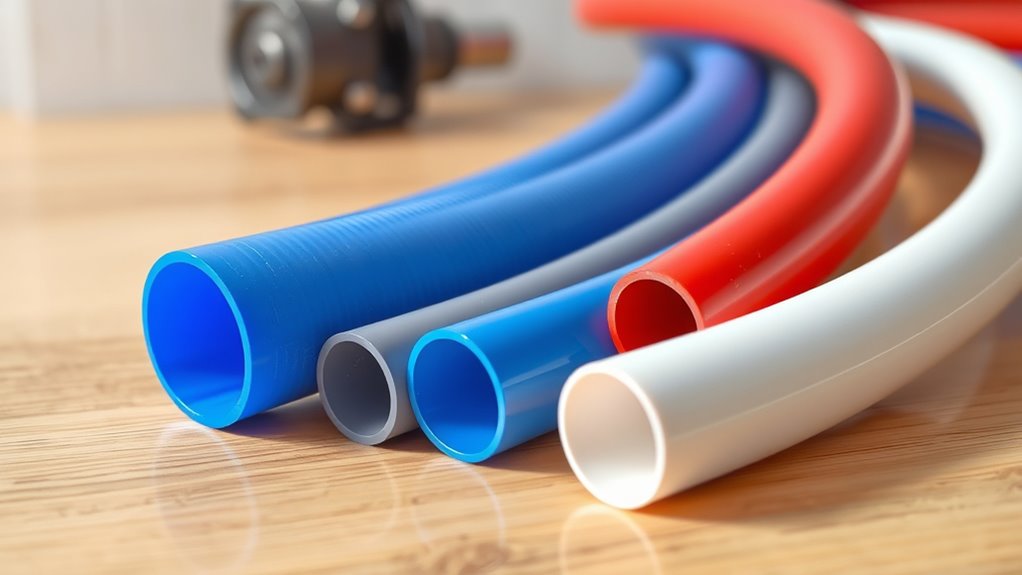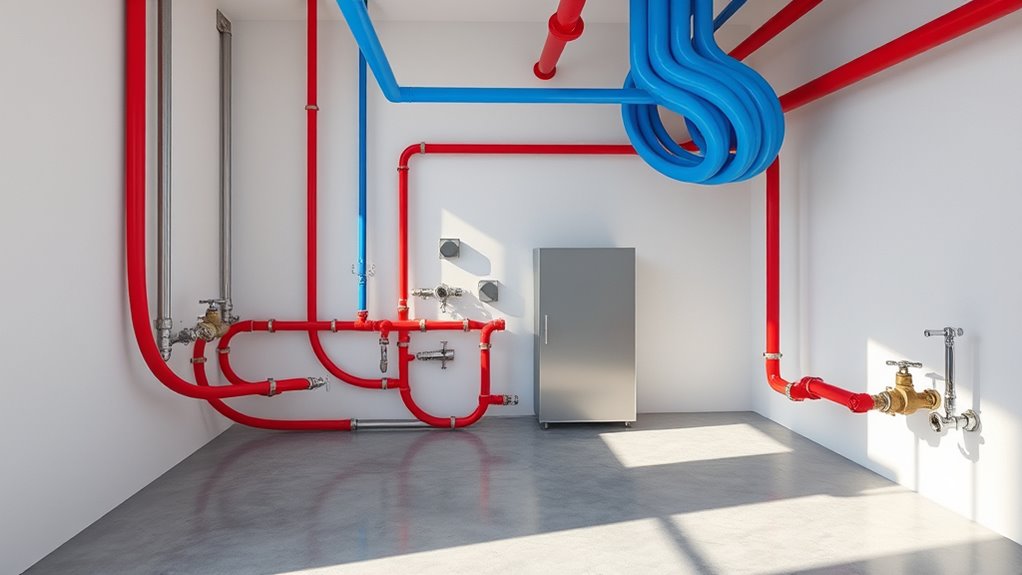PEX pipe, short for cross-linked polyethylene, is a flexible and durable plumbing material known for its resistance to corrosion and temperature fluctuations. It is lightweight, making installation easier and more cost-effective. PEX is suitable for various applications, including residential water supply, radiant heating systems, and outdoor irrigation. Its enhanced flow rates and versatility contribute to its growing popularity. To further understand its features, benefits, and common uses, more insights await.
What Is PEX Pipe?

PEX pipe, short for cross-linked polyethylene, is a flexible plastic plumbing material widely used in residential and commercial applications.
This innovative piping solution is known for its durability, resistance to corrosion, and ability to withstand temperature fluctuations. PEX is available in various diameters and can be easily manipulated to fit different layouts, making it suitable for both new installations and retrofitting.
Its lightweight nature simplifies handling and reduces installation costs. Additionally, PEX offers enhanced flow rates due to its smooth interior surface, minimizing pressure loss.
This material is also less prone to freezing compared to traditional pipes, making it an ideal choice for colder climates.
History of PEX Pipe
The development of cross-linked polyethylene (PEX) pipe can be traced back to the 1960s, when it was first introduced in Europe. The initial creation was driven by the need for more flexible and durable plumbing materials.
By the 1970s, PEX began gaining popularity in various European countries, thanks to its resistance to corrosion and low thermal conductivity. The technology for producing PEX was refined throughout the 1980s and 1990s, leading to increased adoption in North America.
In 1995, PEX received approval for use in plumbing systems in the United States, marking a significant turning point. Since then, PEX has become a widely used option for plumbing applications, favored for its versatility, ease of installation, and cost-effectiveness.
Types of PEX Pipe
There are three main types of PEX pipe, each distinguished by its manufacturing process and characteristics.
PEX-A utilizes a crosslinked method, offering flexibility and resistance to kinking, while PEX-B is known for its superior chemical resistance.
PEX-C, on the other hand, presents a cost-effective solution for various plumbing applications.
PEX-A: Crosslinked Method
While various methods exist for crosslinking polyethylene, PEX-A is distinguished by its unique approach, which enhances the material’s flexibility and resistance to temperature fluctuations.
This method, known as the Engel process, utilizes peroxide to create crosslinks during the manufacturing process. As a result, PEX-A pipes exhibit superior elasticity, allowing them to expand and contract without damage, making them ideal for regions with extreme temperature variations.
Additionally, PEX-A is less prone to cracking and provides excellent resistance to stress and pressure. The manufacturing process also contributes to a smoother inner surface, promoting better flow rates and reducing the risk of mineral buildup.
These characteristics make PEX-A a popular choice among plumbers and contractors for residential and commercial applications.
PEX-B: Chemical Resistance
PEX-B, another popular type of crosslinked polyethylene pipe, is recognized for its robust chemical resistance.
This characteristic makes it suitable for various applications, including potable water systems and heating installations, where exposure to different chemicals is common.
PEX-B can withstand a range of substances such as acids, bases, and alcohols, which is essential for ensuring the longevity and integrity of plumbing systems.
Additionally, its resistance to scaling and chlorine allows for cleaner water and reduces the need for frequent replacements.
Unlike some materials, PEX-B does not corrode or rust, which further enhances its durability in challenging environments.
PEX-C: Cost-Effective Solution
Among the various types of PEX pipes, PEX-C stands out as a cost-effective solution for plumbing and heating applications.
Produced using a cold expansion method, PEX-C offers a balance of affordability and performance, making it an attractive option for homeowners and contractors alike. Its lower manufacturing costs translate into savings for consumers, while still providing excellent flexibility and resistance to scale and chlorine.
PEX-C is particularly beneficial for retrofitting projects, where budget constraints are often a concern. Additionally, its lightweight nature reduces installation costs, as it requires less labor and fewer tools.
Key Features of PEX Pipe
One of the standout qualities of PEX pipe is its flexibility, allowing for easier installation in various plumbing configurations. This adaptability enables it to bend around obstacles without the need for additional fittings, reducing potential leak points. PEX is also resistant to corrosion, scaling, and chlorine, ensuring longevity in plumbing systems. In addition, it has a lower thermal conductivity, which helps in maintaining water temperature.
| Feature | Description |
|---|---|
| Flexibility | Bends easily around obstacles |
| Corrosion Resistance | Durable against rust and scale |
| Low Thermal Conductivity | Maintains water temperature well |
| Lightweight | Easier to handle and install |
These key features contribute to PEX pipe’s growing popularity in residential and commercial applications.
Advantages of Using PEX Pipe
While many plumbing materials have their merits, the advantages of using PEX pipe are particularly compelling. This flexible and durable piping option is gaining popularity among homeowners and contractors alike.
Key benefits include:
- Flexibility: PEX can bend around corners and obstacles, reducing the need for numerous fittings.
- Resistant to Corrosion: Unlike metal pipes, PEX does not corrode, ensuring a longer lifespan.
- Ease of Installation: Lightweight and easy to handle, PEX installation requires fewer tools and can be completed more quickly.
- Temperature Resistance: PEX can withstand both hot and cold temperatures, making it suitable for various applications.
These advantages make PEX pipe an increasingly preferred choice for modern plumbing systems.
Disadvantages of PEX Pipe
While PEX pipes offer numerous advantages, they also come with several disadvantages that should be considered.
These include limitations regarding temperature tolerance, sensitivity to UV light, and a cost structure that may be higher compared to alternative piping options.
Understanding these drawbacks is essential for making informed decisions in plumbing projects.
Temperature Limitations
Although PEX pipe offers numerous advantages for plumbing systems, it does come with notable temperature limitations that can affect its performance.
PEX is generally rated for temperatures up to 200°F (93°C), but prolonged exposure to high temperatures can compromise its structural integrity.
Additionally, low temperatures can also pose risks, as PEX is susceptible to freezing if not properly insulated.
The following points summarize its temperature limitations:
- Maximum Temperature: Limited to 200°F (93°C) for safe operation.
- Freezing Risk: Susceptible to freezing, requiring insulation in cold climates.
- Heat Loss: Potential for heat loss in hot water applications.
- Deformation: Can deform under excessive heat, leading to leaks.
These limitations must be considered when selecting PEX for specific installations.
UV Sensitivity Issues
PEX pipe’s vulnerability to ultraviolet (UV) light is a significant drawback that can impact its longevity and performance.
When exposed to direct sunlight, PEX can degrade, leading to a loss of structural integrity and increased brittleness over time. This deterioration can result in cracks and leaks, compromising the effectiveness of plumbing systems.
In addition, UV exposure can cause discoloration, affecting the aesthetic appeal of installations. As a result, PEX should not be used in outdoor applications unless adequately protected by insulation or coatings.
Homeowners and contractors must consider this limitation when planning projects, ensuring that PEX is installed in locations shielded from UV rays to maximize its lifespan and reliability in plumbing and heating systems.
Cost Compared to Alternatives
When evaluating plumbing materials, cost is an essential factor that often emerges in discussions about PEX pipe. While PEX is generally more affordable than traditional copper or PVC options, there are several considerations that may affect its overall value:
- Initial Installation Cost: PEX may have lower material costs, but labor expenses can vary based on installation complexity.
- Replacement Costs: If PEX is damaged, repairs can be more expensive than other materials due to the need for specialized fittings.
- Longevity: PEX typically has a shorter lifespan compared to copper, leading to potential early replacement.
- Value in Extreme Conditions: In areas with extreme temperatures, PEX may be less reliable, resulting in additional costs for insulation or replacements.
These factors can influence the long-term cost-effectiveness of PEX pipe.
Comparison: PEX vs. Copper vs. PVC
A thorough comparison of PEX, copper, and PVC pipes reveals distinct advantages and disadvantages for each material. PEX offers flexibility and resistance to corrosion, making it ideal for various plumbing applications. Copper, while durable and long-lasting, can be more expensive and is susceptible to temperature changes. PVC, known for its affordability and lightweight nature, is typically used for drainage and irrigation but lacks flexibility and can degrade under UV light.
| Material | Advantages |
|---|---|
| PEX | Flexible, corrosion-resistant |
| Copper | Durable, long-lasting |
| PVC | Affordable, lightweight |
Common Applications of PEX Pipe
Considering its versatility and advantageous properties, PEX pipe has become a popular choice for a variety of plumbing applications.
Its flexibility, resistance to scale and chlorine, and ease of installation make it suitable for numerous uses.
Common applications of PEX pipe include:
- Residential Water Supply: Ideal for both hot and cold water lines in homes.
- Radiant Heating Systems: Efficiently used for underfloor heating projects due to its thermal properties.
- Repipe Projects: An excellent option for replacing old piping in renovations, minimizing disruption.
- Outdoor Plumbing: Suitable for irrigation systems and outdoor water lines, thanks to its durability against weather conditions.
These diverse applications highlight PEX pipe’s significance in modern plumbing solutions.
PEX Pipe Installation Process
The installation process of PEX pipe involves careful preparation and planning to guarantee ideal performance and longevity.
Selecting appropriate connection techniques and tools is essential for a successful setup. Understanding these elements can greatly streamline the installation process and enhance overall effectiveness.
Preparation and Planning
Before commencing the installation of PEX piping, meticulous preparation and planning are essential to secure a smooth process and ideal performance.
Homeowners and professionals alike should consider the following key steps:
- Assess the Space: Evaluate the area where PEX will be installed, noting any obstacles and dimensions.
- Select Appropriate PEX Type: Choose between the various PEX types (PEX-A, PEX-B, PEX-C) based on project requirements.
- Gather Necessary Tools and Materials: Confirm all tools, fittings, and accessories are on hand to avoid interruptions during installation.
- Create a Detailed Plan: Draft a layout that outlines pipe routes and connections, confirming compliance with local building codes.
Proper preparation lays the groundwork for a successful PEX installation.
Connection Techniques and Tools
Numerous connection techniques and tools are available for PEX pipe installation, each designed to guarantee secure and leak-free joints. The most common methods include crimping, clamp (or cinch) connections, and push-fit fittings. Each method requires specific tools, such as crimpers, clamps, and insertion tools.
| Connection Method | Tools Required | Pros |
|---|---|---|
| Crimping | Crimping Tool | Reliable, strong |
| Clamp | Clamp Tool | Easy to install |
| Push-Fit | None (push-in) | Quick, no tools |
Selecting the appropriate technique and tool depends on the project requirements and the user’s level of expertise. Proper installation guarantees longevity and functionality of the PEX system.
Tools Required for PEX Pipe Installation
Successful PEX pipe installation requires a specific set of tools that facilitate a seamless process. Proper tools not only enhance efficiency but also guarantee the integrity of the plumbing system.
Essential tools for this task include the following:
- PEX Cutter: A specialized tool designed to make clean, straight cuts in PEX tubing, which is vital for proper connections.
- Crimping Tool: Used for securing fittings onto the pipe, assuring a leak-proof seal.
- Expansion Tool: Necessary for expanding the end of PEX pipe for certain types of fittings, allowing for a secure fit.
- Pipe Support Clips: Helps to secure the PEX tubing to walls or ceilings, preventing movement and potential damage.
Utilizing these tools can markedly enhance the installation process.
PEX Pipe Fittings and Connectors
PEX pipe fittings and connectors play an essential role in creating a reliable plumbing system. These components are designed to join sections of PEX piping securely, ensuring leak-free connections.
Available in various types, such as crimp, clamp, and push-fit, each fitting type offers distinct advantages based on specific application needs. Additionally, they come in a range of sizes to accommodate different pipe diameters.
The flexibility of PEX allows for easier installation, particularly in tight spaces, while the fittings maintain structural integrity under varying temperatures and pressures.
With their resistance to corrosion and scale build-up, PEX fittings and connectors contribute to the longevity of plumbing systems. Proper selection and installation of these components are vital for ideal performance.
Maintenance of PEX Pipe Systems
Maintaining PEX pipe systems is essential for guaranteeing their longevity and efficiency. This involves routine inspections and checks, as well as employing effective cleaning and flushing techniques.
Additionally, implementing reliable leak detection methods can help prevent costly damage and guarantee peak performance.
Routine Inspections and Checks
Regular inspections and checks are essential for ensuring the longevity and effectiveness of PEX pipe systems.
These routine evaluations help identify potential issues before they escalate, ensuring peak performance. Homeowners and professionals alike should focus on specific areas during inspections, including:
- Visible Damage: Check for any signs of cracking, kinking, or wear on visible sections of the pipe.
- Connections: Inspect all connections and fittings for leaks or signs of deterioration.
- Temperature Fluctuations: Monitor areas exposed to extreme temperatures to prevent expansion or contraction damage.
- Water Quality: Observe any changes in water quality, such as discoloration or odor, which may indicate underlying problems.
Regularly addressing these factors can greatly enhance the reliability and lifespan of PEX pipe systems.
Cleaning and Flushing Techniques
Effective cleaning and flushing techniques play a crucial role in maintaining the efficiency of PEX pipe systems. Regular cleaning helps to prevent the buildup of sediments, biofilm, and mineral deposits that can compromise water quality and flow rates.
Flushing the system involves running water at a high velocity to dislodge any contaminants. It is advisable to perform this procedure periodically, especially in systems that have been idle for extended periods.
Additionally, using specialized cleaning solutions can enhance the cleaning process without damaging the PEX material. Operators should guarantee that the flushing process adheres to local guidelines and regulations to maintain water safety.
Proper maintenance not only extends the lifespan of the pipes but also ensures peak system performance.
Leak Detection Methods
Detecting leaks in PEX pipe systems is essential for preserving water quality and preventing costly damage. Various methods exist to identify these leaks effectively:
- Visual Inspection: Regularly check for signs of water accumulation or damp spots around fittings and joints.
- Pressure Testing: Utilize a pressure gauge to assess system integrity; a drop in pressure may indicate a leak.
- Acoustic Detection: Employ specialized equipment that amplifies sound waves, allowing for pinpointing of leaks based on noise.
- Dye Testing: Introduce a non-toxic dye into the system to trace flow paths and reveal hidden leaks.
PEX Pipe and Water Quality
While PEX pipe is widely praised for its flexibility and ease of installation, concerns about water quality often arise among homeowners and builders. One primary issue is the potential leaching of chemicals from the pipe into the water supply.
Research indicates that some types of PEX can release substances like ethylene glycol, particularly when exposed to high temperatures. However, many manufacturers produce PEX that meets stringent safety standards, including NSF/ANSI 61 certification, guaranteeing minimal impact on water quality.
Additionally, PEX is resistant to corrosion and scaling, which helps maintain water quality over time. Regular maintenance and monitoring can further mitigate concerns, making PEX a viable option for plumbing systems when proper precautions are taken to guarantee safe drinking water.
Cost Considerations for PEX Pipe
When evaluating plumbing options, cost considerations for PEX pipe play an essential role for homeowners and contractors alike. The initial investment in PEX may be higher than traditional materials such as copper or PVC; however, its long-term savings can be significant.
Key factors influencing the overall cost include:
- Material Costs: PEX generally has lower material costs compared to copper.
- Installation Labor: PEX is easier to install, often reducing labor costs.
- Durability: Its resistance to corrosion and scaling can lead to fewer repairs over time.
- Energy Efficiency: PEX’s insulation properties can reduce heating costs in hot water systems.
Understanding these factors helps stakeholders make informed decisions regarding plumbing investments.
Future of PEX Pipe in Plumbing Systems

As the demand for efficient and cost-effective plumbing solutions continues to rise, the future of PEX pipe in plumbing systems appears promising.
Its flexibility, resistance to corrosion, and ease of installation position PEX as a preferred choice among both homeowners and professionals.
With ongoing advancements in manufacturing technology, the durability and performance of PEX pipes are expected to improve further, enhancing their appeal in various applications.
Additionally, as sustainability becomes a priority in construction, PEX’s energy-efficient properties may lead to increased adoption in eco-friendly building projects.
Regulatory bodies are also gradually updating standards to accommodate PEX, which could facilitate its broader use.
Conclusion
To summarize, PEX pipe has revolutionized plumbing systems with its versatility and efficiency. Remarkably, over 80% of new homes in the United States now utilize PEX for their water supply lines, highlighting its growing prominence in modern construction. With its ability to withstand extreme temperatures and resist corrosion, PEX not only enhances water quality but also promises cost-effective solutions for homeowners. As the industry evolves, PEX continues to pave the way for innovative plumbing practices.

I’m Allen Kim, the chief editor of plumbinginto. I am a mid level plumber and assign to an local firm over 4 years of experience. During the working period, most of my experience is related to the house plumbing. I learned about the thing, when working with most experienced people in this sector, one must be as good as the inspector or better with knowledge of the project as well as the practical aspects of plumbing industry.